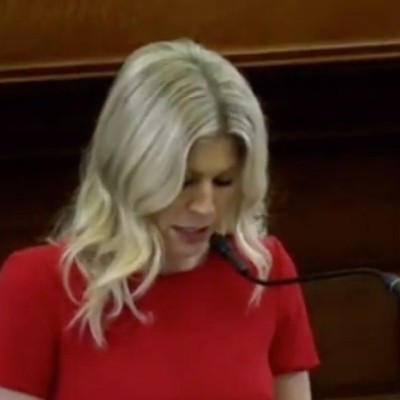Photo by Daniel Kramer / Click here for a slideshow
It’s probably safe to say that other than the communities on the Bolivar Peninsula, no places in Texas were ravaged worse by Hurricane Ike than the bayside Chambers County towns of Oak Island and Smith Point.
In the case of Oak Island, as with San Leon, Press photographer Daniel Kramer and I crossed a police checkpoint and were allowed in after showing media credentials. The Department of Public Safety turned us away from Smith Point, citing extensive property damages.
But that begs the question – why then were we allowed into Oak Island? It is certainly difficult to conceive of a place more destroyed, by either man or nature. Chambers County bore the brunt of the dirty side of Ike – and the surge that wiped Bolivar clean crested there on the banks of Trinity Bay. An insurance adjuster who did not want to be named told me that the damage here was as bad as anything Katrina wrought.
On the outskirts of Oak Island, at the town mini-mart, owner Tuan Nguyen invited me in to see the ruins of his inventory, but a nearby health inspector advised me against it. “You’d better wear a mask if you wanna go in there, buddy,” he said.
As you round the corner and arrive in Oak Island proper, such is the devastation, it is hard to tell what the essential character of Oak Island had been before Ike.
All that can be said with any certainty is that it had been on lovely, golf course-type grounds, studded with scrubby oaks and interlaced with bayous and canals, all facing Trinity Bay.
Now, the grounds were ankle deep in vacuum cleaners, broken glass, tidal wrack, trophy heads, lawn jockeys, lawn mowers, motor scooters, crockery, microwave ovens, stereos, albums, you name it. One ditch positively brims with sludge-drenched bottles of wine from the utterly destroyed Frascone Winery, Oak Island’s only vintner. It was as if a squadron of C-130s had bombed the town with stuff.
In contrast with San Leon, which is already loud with the rumble of heavy equipment, the thrum of generators, and even the sound of music, Oak Island was almost as quiet as it was in primeval days. You could hear Trinity Bay’s waves gently lapping at the riprap on the shore, on which there lay drowned rabbits and nutrias.
Few houses were left as anything more than mere slabs. Near one very tall house that had been wind-certified by the state of Texas, several men were sweeping out debris.
“It’s pretty amazing,” says one of them, 40-year-old Lowell Stanton. “This was a subdivision. Now you can’t even tell there had been a subdivision here.
“There was a two-story house here, another one there, and these houses go back to the ‘50s and ‘60s,” added his father, Ed Stanton. “Our house went through Carla, after a fashion and Alicia – we had it then. And of course we don’t have it after Ike.”
“We are fortunate that we just had this as a weekend place,” he added. “There were a lot of people that lived here full-time.”
Small world alert: A third man with the Stantons turned out to be David Angel, a guy I played football with at Strake Jesuit back in the ‘80s. The two of us got talking about Crystal Beach, one of the few places more destroyed than Oak Island.
“My aunt sent us a picture of Gilchrist in 1961 after Carla,” he said. “You can lay that one side by side with what happened with Ike, and it looks the same. It’s just the way things go down here. There’s no reason to be weird about it. People love the coast, and they will rebuild.”
Not far away, under a beach umbrella, there sat Howard Hanks, amid piles of empty MRE wrappers, beer cans and cases of emergency-issued drinking water. Behind him was the slab on which his year-round home once stood, under a Rebel flag bearing the legend “The South Will Rise Again.”
The fiftysomething semi-retired jack-of-all-trades had moved to Oak Island from his native town of Ft. Walton Beach, Florida eight years ago. He said that local residents were told the storm surge might be as high as four to eight feet at worst, which had him thinking he was gonna take some pain-in-the-butt water damage, but nothing catastrophic. “I was thinkin’ aw man, I’m gonna get a foot of water in my house if it comes up to the max,” Hanks said. That figure kept getting revised upward, as Hanks heard from reports in West Texas, where he evacuated. “On Friday night, people at Gilchrist and Crystal Beach were saying they were gettin’ water shooting up through the floors on the second floor,” he went on. “If it was gonna come up through the floor joists like that, that meant the water had to be ten or 15 feet. So then I thought, ‘Man, my house is gonna be flooded. All my stuff’s gonna be floatin’ around in my house. I was glad I tied everything down. That’s the reason there’s so much rope around here.”
And then the beast’s true nature was finally revealed in total when the surge finally plowed over the Bolivar Peninsula and crested here in Chambers County on the mainland proper.
“When it came ashore at Smith Point, they was able to estimate what was hapennin’, ‘cause they can’t do it when it was in the water. So then they were sayin’ it was 18-to-25 foot, and we were just goin’ ‘What’s goin’ on? I can’t believe this.’ Somebody I guess didn’t know how to read those buoys out there.”
Hanks said he returned Sunday to find his life washed away, along with those of everybody else in his hometown. “I had $300 worth of silver dollars, and I haven’t found them yet,” he says, between nips off a Miller Lite. “I have been findin’ my rolls of quarters. I’d been collectin’ them for my grandkids – all the different states.”
Hanks added that he had been finding wine from Frascone – he did oddjobs there in better times -- scattered throughout the town. “Whenever I find a bottle, I just set it on that stump over there and whoever wants it can take it.”
Today, his dog is in the Chambers County SPCA – “He stepped on a nail a while ago, so he’s gettin’ looked after up there,” he said. Hanks spends his days moving his stuff around, disentangling power cords that are entwined like spaghetti through the town’s eponymous oaks, making plans for the future.
“When I get through this, I’m just gonna get me one of everything,” he said. “One knife, one cup, one plate.” Asked if he planned to return to Oak Island, he said “Of course I am. This here was like an Eden. But when I come back, I’m gonna be in a trailer. I plan to always have some wheels under my ass.”
Kramer and I next drove over to the historically black village of Double Bayou, some ten miles inland from the bay. The little town is home to the Double Bayou Dance Hall of Gulf Coast blues legend, and the Dance Hall itself looked like it hadn’t been used for many months before the storm. Now, it is literally falling apart at the seams, and a large oak branch hangs broken and precarious over the roof.
Around the corner from the dance-hall, Stacy and Leslie Holmes and their friend Todd White sat on the front porch of the Moore home drinking beer. Even at this distance from the saltwater, they said, the storm surge lapped at their very doorstep.
“I’ve lived here 31 years and never seen that,” says Stacy. “Everybody I’ve talked to says the same thing – they never have either.”
Their local constable had to be rescued off his roof after five hours in the storm, the bridge over one branch of Double Bayou was overtopped for the first time in living memory.
But it wasn’t just the surge that had them terrified in Double Bayou. Here, it was the tornados, windstorms that ripped through Chambers County’s forests like freight trains.
“Nobody I talked to said they wanted to stay through another one,” says Stacy. “I’m gonna evacuate next time for sure,” added Leslie, her husband. “Ain’t nobody asked me, but if they did, I’d tell ‘em I ain’t goin’ nowhere,” laughed White.
The area around Double Bayou is hardcore cattle country, and talk there is starting to center on long-term damage to the pasturelands and stock tanks from saltwater contamination.
“They can’t eat saltwater grass and they have to have freshwater, so if you keep them here they will die,” said Leslie.
“The cattle industry down here is down and out,” says Stacy.
“They’re haulin’ cattle off out of here by the thousands,” added White. “Big 18-wheelers comin’ down here.”
But inland, they are still gripped by the fear of the storm’s actual fury rather than worrying about the future. Well, at least some of them, like the Moores, are scared. White has another view.
“No, I won’t stay through another one,” said Leslie. “We were over at her mom and dad’s house…”
“And I was up with my mom, ‘cause she was like paranoid,” added Stacy. The Moores are one of those couples that finish each other’s sentences.
Leslie: “The walls were rumbling like a freight train was passing.”
Stacy: “It was bad. And it was all night! For like five hours!”
And then White chimed in with what seems very much like his customary role as comic relief: “Hell, I woke up ‘bout the time it hit, and I sat up for about two or three hours and I said ‘Hell this ain’t ‘bout shit.’ And I went back to sleep.”
– John Nova Lomax






